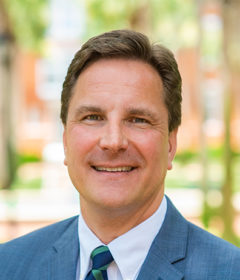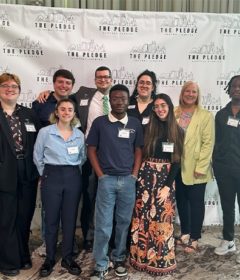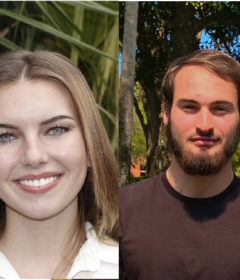Touching the ‘Unvarnished Story’
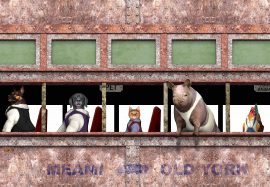
At first glance of “Unvarnished Story,” the works in the Hand Art Center’s Faculty Focus exhibit seem arranged to amuse. The figures in Dengke Chen’s “Segregated Water Fountains,” an unframed print hanging from tiny clips, are not humans but animals. One, a dog in a crisp suit, is at a sleek retro fountain, while the pig beside him, in ill-fitting rags, guzzles at a rusty faucet.
A variety of animals perch on a steel beam, high above the city in Chen’s “Lunchtime Atop a Skyscraper.” Their overalls and box lunches suggest the iconic 1932 image of Rockefeller Center under construction, and yet … not.
These figures, like the others in Chen’s 2016 mixed-media pieces, look like pigs, dogs, bears, cats, and other domesticated or wild creatures. But, however realistic their appearances, these animals dress and behave like humans, and that is initially hilarious. The cat holds a box of “cookies,” and the rabbit shares his carrot with a rooster.
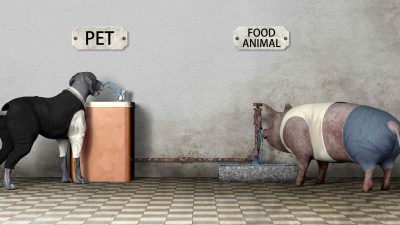
Then we look at the bear in overalls, balancing a box on his knees and preparing to munch on a human leg. The wolf next to him has taken a piece from the bear’s “Meat: Lunch Size” box and is about to devour another leg. Suddenly the caricature, with such precise details, isn’t quite so funny. Who are these steel workers? How are they different from the heroic workers in the original image? How does the difference affect viewers?
And, noted Chen, what happens when the viewer goes one step further and picks up one of the tablets in the exhibit? Point the tablet at the works, one at a time, and a video game begins to play. Sound and image bombard the viewer, and the static image comes to life, taking on different, dizzying dimensions.
“I would call my new works multimedia interactive games,” said Chen, an assistant professor of digital arts at Stetson. “You have prints, the computer games and augmented and virtual reality, combined with computer animation. I want to criticize social patterns – racism, animal rights, environmental concerns.”
“All of the images were originally photographs, famous pictures. I found them interesting, with lots of meaning,” he added, walking up to “Segregated Water Fountain” during a recent tour of his exhibit and pointing out the signs over each fountain: “Pet” for the pampered dog and “Food Animal” for the humble pig. “There was bias in the original photo, of Civil Right Era drinking fountains that separated black and white people.”
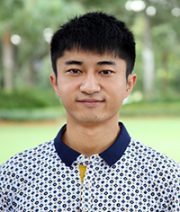
His artwork is on exhibit in the Hand Art Center on the Stetson University DeLand campus until March 3. Chen will explain his ideas and working processes at a talk set for 7 p.m. Thursday, Feb. 16, on the Stetson campus in the duPont-Ball Library’s Room 25L.
The way people treat animals is biased, Chen said, as is the way humans treat one another.
“But even among the ways people treat animals there is bias. In this culture, we sleep with our pets and keep our food animals in pens or prisons. We hunt the deer, the bear, the boar; the animal has no rights. The pig in ‘The Falling Man’ is as helpless as the man falling from the Twin Towers on 9/11. And the pig at the rusty fountain has no choice – he has to drink here,” Chen explained.
Yet, pick up the tablet, activate the video game and the story changes – and that makes “Unvarnished Story” very different from the usual gallery exhibit.
“Students love this hands-on approach, but the general public has to be encouraged to touch the tablets and engage directly in the works,” said Tonya Curran, director of the Hand Art Center.
“Many of us have been conditioned ‘not to touch’ anything in the museum environment, so it often escapes their notice that they are allowed to pick up the technology.”
They are not merely allowed the opportunity – viewers are encouraged to actively engage in the exhibit, and the ideas it vividly embodies.
“I like the humorous part, the dark humor of having people walking like pigs and reversing animal/human roles,” Chen said. “I would say, as an activist, how can you use art to change people’s thoughts and behavior?
“This is how I do it; this is why I ‘do’ art.”
-Laura Stewart
The Hand Art Center is free and open to the public. Visit its website for hours and a visitors’ parking map.

